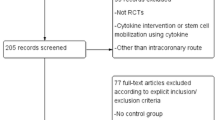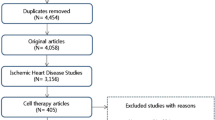Abstract
Multiple clinical trials have been performed to test the hypothesis that administration of bone-marrow-derived progenitor and stem cells (BMCs) may improve left-ventricular (LV) function following acute myocardial infarction (AMI). These studies have generally confirmed that cell therapy administration can be safely administered; however, consensus has not been reached on whether this approach results in an improvement in LV function or clinical outcomes. Although many of the published studies have been randomized, placebo-controlled trials, many important questions regarding patient selection, methodology and trial design still exist. To date, almost no information has been obtained in regard to optimal dosing and cell type, timing of administration and preferred method of delivery. As a result, current cell therapy administration for AMI finds itself at the crossroads. In this review we have highlighted some of the important questions that remain unanswered in the field of cell therapy after AMI. We believe that future cell therapy trials should attempt to incorporate these important issues in designing upcoming clinical trials in order for the field to move forward.
Similar content being viewed by others
References
Tomita, S., Li, R-K., Weisel, R. D., Mickle, D. A., Kim, E. J., Sakai, T., et al. (1999). Autologous transplantation of bone marrow cells improves damaged heart function. Circulation, 100(suppl II), II–247-II-256.
Orlic, D., Kajstura, J., Chimenti, S., Jakoniuk, I., Anderson, S. M., Li, B., et al. (2001) Bone marrow cells regenerate infracted myocardium. Nature, 410, 701–705.
Murry, C. E., Soonpa, M. H., Reinecke, H., Nakajima, H., Nakajima, H. O., Rubart, M., et al. (2004) Haematopoietic stem cells do not transdifferentiate into cardiac myocytes in myocardial infarcts. Nature, 428, 664–668.
Balsam, L. B., Wagers, A. J., Christensen, J. L., Kofidis, T., Weissman, I. L., Robbins, R. C. (2004) Haematopoietic stem cells adopt mature haematopoietic fates in ischaemic myocardium. Nature, 428, 668–673.
Orlic, D., Kajstura, J., Chimenti, S., Limana, F., Jakoniuk, I., Quaini, F., et al. (2001) Mobilized bone marrow cells repair the infracted heart, improving function and survival. PNAS, 98, 10344–10349.
Amado, L. C., Saliaris, A. P., Schuleri, K. H., St. John, M., Xie, J-S., Cattaneo, S., et al. (2005) Cardiac repair with intramyocardial injection of allogeneic mesenchymal stem cells after myocardial infarction. PNAS, 102, 11474–11479.
Uemura, R., Xu, M., Ahmad, N., Ashraf, M. (2006) Bone marrow stem cells prevent left ventricular remodeling of ischemic heart through paracrine signaling. Circulation Research, 98, 1414–1421.
Kinnaird, T., Stabile, E., Burnett, M. S., Lee, C. W., Barr, S., Fuchs, S., et al. (2004) Marrow-derived stromal cells express genes encoding a broad spectrum of arteriogenic cytokines and promote in vitro and in vivo arteriogenesis through paracrine mechanisms. Circulation Research, 94, 678–685.
Kawamoto, A., Iwasaki, H., Kusano, K., Murayama, T., Oyamada, A., Silver, M., et al. (2006) CD34-positive cells exhibit increased potency and safety for therapeutic neovascularization after myocardial infarction compared with total mononuclear cells. Circulation, 114, 2163–2169.
Kocher, A. A., Schuster, M. D., Szabolcs, M. J., et al. (2001) Neovascularization of ischemic myocardium by human bone-marrow-derived angioblasts prevents cardiomyocyte apoptosis, reduces remodeling and improves cardiac function. Natural Medicines, 7, 430–436.
Beltrami, A. P., Barlucchi, L., Torella, D., Baker, M., Limana, F., Chimenti, S., et al. (2003) Adult cardiac stem cells are multipotent and support myocardial regeneration. Cell, 114, 763–776.
Strauer, B. E., Brehm, M., Zeus, T., et al. (2002) Repair of infarcted myocardium by autologous intracoronary mononuclear bone marrow cell transplantation in humans. Circulation, 106, 1913–1918.
Assmus, B., Schachinger, V., Teupe, C., et al. (2002) Transplantation of progenitor cells and regeneration enhancement in acute myocardial infarction (TOPCARE-AMI). Circulation, 106, 3009–3017.
Fernandez-Aviles, F., San Roman, J. A., Garcia-Frade, J., et al. (2004) Experimental and clinical regenerative capability of human bone marrow cells after myocardial infarction. Circulation Research, 95, 742–748.
Wollert, K. C., Meyer, G. P., Lotz, J., et al. (2004) Intracoronary autologous bone-marrow cell transfer after myocardial infarction: the BOOST randomized controlled clinical trial. Lancet, 364, 141–148.
Schachinger, V., Erbs, S., Elsasser, A. et al. (2006) Intracoronary bone marrow-derived progenitor cells in acute myocardial infarction. NEJM, 355, 1210–1221.
Lunde, K., Solheim, S., Aakhus, S., et al. (2006) Intracoronary injection of mononuclear bone marrow cells in acute wall infarction. NEJM, 355, 1199–1209.
Janssens, S., Dubois, C., Bogaert, J., et al. (2006) Autologous bone marrow-derived stem-cell transfer in patients with ST-segment elevation myocardial infarction: double-blind, randomized controlled trial. Lancet, 367, 113–121.
Abdel-Latif, A., Bolli, R., Tleyjeh, I. M., Montori, V. M., Perin, E. C., Hornung, C. A., et al. (2007) Adult bone marrow-derived cells for cardiac repair. A systematic review and meta-analysis. Archives of Internal Medicine, 167, 989–997.
Lipinski, M. J., Biondi-Zoccai, G. G. L., Abbate, A., Khianey, R., Sheiban, I., Bartunek, J., et al. (2007) Impact of intracoronary cell therapy on left ventricular function in the setting of acute myocardial infarction. JACC, 50, 1761–1767.
Ii, M., Nishimura, H., Iwakura, A., Wecker, A., Eaton, E., Asahara, T., et al. (2005) Endothelial progenitor cells are rapidly recruited to myocardium and mediate protective effect of ischemic preconditioning via “imported” nitric oxide synthase activity. Circulation, 111, 1114–1120.
Tsang, A., Hausenloy, D. J., Mocanu, M. M., Yellon, D. M. (2004) Postconditioning: A form of “modified reperfusion” protects the myocardium by activating the phosphatidylinositol 3-kinase-Akt pathway. Circulation Research, 95, 230–232.
Ma, J., Ge, J., Zhang, S., et al. (2005) The time course of myocardial stromal cell-derived factor 1 expression and beneficial effects of intravenously administered bone marrow stem cells in rats with experimental myocardial infarction. Basic Research in Cardiology, 100, 1–7.
Askari A. T., Unzek S., Popovic, Z. B., et al. (2003) Effect of stromal-cell-derived factor 1 on stem cell homing and tissue regeneration in ischaemic cardiomyopathy. Lancet, 362, 697–703.
Hou, D., Youssef, E. A., Brinton, T. J., Zhang, P., Rogers, P., Price, E. T. et al. (2005) Radiolabeled cell distribution after intramyocardial, intracoronary, and interstitial retrograde coronary venous delivery. Circulation, 112(suppl I), I–150-I-156.
Hare, J. M., Traverse, J. H., Henry, T. D., Dib, N., Strumpf, R., Schulman, S., et al. (2008). A randomized, double-blind, placebo-controlled, dose-escalation study of intravenous adult human mesenchymal stem cells (ProvacelTM) following acute myocardial infarction. Lancet (in press).
Hofmann, M., Wollert, K. C., Meyer, G. P., Menke, A., Arseniev, L., Hertenstein, B., et al. (2005) Monitoring of bone marrow cell homing into the infracted human myocardium. Circulation, 111, 2198–2202.
Aggarwal, S., Pittenger, M. F. (2005) Human mesenchymal stem cells modulate allogeneic immune cell responses. Blood, 105, 1815–1822.
Schuster, M. D., Kocher, A. A., Seki, T., Martens, T. P., Xiang, G., Homma, S. et al. (2004) Myocardial neovascularization by bone marrow angioblasts result in cardiomyocyte regeneration. American Journal of Physiology, 287, H525–H532.
Bartunek, J., Vanderheyden, M., Vandekerckhove, B., et al. (2005) Intracoronary injection of CD133-positive enriched bone marrow progenitor cells promotes cardiac recovery after recent myocardial infarction. Circulation, 112(Suppl I), I–178–I–183.
Vulliet, P. R., Greely, M., Halloran, S. M., MacDonald, K. A., Kittleson, M. D. (2004) Intra-coronary arterial injection of mesenchymal stromal cells and microinfarction in dogs. Lancet, 363, 783–784.
Chen, S., Fang, W., Ye, F., Liu, Y., Qian, J., Shan, S., et al. (2004) Effect on left ventricular function of intracoronary transplantation of autologous bone marrow mesenchymal stem cell in patients with acute myocardial infarction. American Journal of Cardiology, 94, 92–95.
Meluzin, J., Mayer, J., Groch, L., Janousek, S., Hornacek, I., Hilnomaz, O., et al. (2006) Autologous transplantation of mononuclear bone marrow cells in patients with acute myocardial infarction: The effect of the dose of transplanted cells on myocardial function. American Heart Journal, 975, e9–e15.
Solomon, S. D., Glynn, R. J., Greaves, S., Ajani, U., Rouleau, J-L., Menapace, F., et al. (2001) Recovery of ventricular function after myocardial infarction in the reperfusion era: The healing and early afterload reducing therapy study. Annals of Internal Medicine, 134, 451–458.
Solomon, S. D., Anavekar, N., Skali, H., McMurray, J. J. V., Swedberg, K., Yusuf, S. et al. (2005) Influence of ejection fraction on cardiovascular outcomes in a broad spectrum of heart failure patients. Circulation, 112, 3738–3744.
Tarantini, G., Cacciavillani, L., Corbetti, F., Ramondo, A., Marra, M. P., Bacchiega, E., et al. (2005) Duration of ischemia is a major determinant of transmurality and severe microvascular obstruction after primary angioplasty. JACC, 46, 1229–1235.
Schwartz, R. S. (2005) Microvascular obstruction in acute coronary syndromes: Onward to a new therapeutic target. Cath and Cardiovasc Int, 66, 170–172.
Rochitte, C. E., Lima, J. A. C., Bluemke, D. A., Reeder, S. B., McVeigh, E. R., Furata, T., et al. (1998) Magnitude and time course of microvascular obstruction and tissue injury after acute myocardial infarction. Circulation, 98, 1006–1014.
WuK, C., Zerhouni, E. A., Judd, R. M., Lugo-Olivieri, C. H., Barouch, L. A., Schulman, S. P., et al. (1998) Prognostic significance of microvascular obstruction by magnetic resonance imaging in patients with acute myocardial infarction. Circulation, 97, 765–772.
Hombach, V., Grebe, O., Merkle, N., Waldenmaier, S., Hoher, M., Kochs, M. et al. (2005) Sequelae of acute myocardial infarction regarding cardiac structure and function and their prognostic significance as assessed by magnetic resonance imaging. European Heart Journal, 26, 549–557.
Heiss, C., Keymel, S., Niesler, U., Ziemann, J., Kelm, M., Kalka, C. (2005) Impaired progenitor cell activity in age-related endothelial dysfunction. JACC, 45, 1441–1448.
Heeschen, C., Lehmann, R., Honold, J., Assmus, B., Aicher, A., Walter, D. H., et al. (2004) Profoundly reduced neovascularization capacity of bone marrow mononuclear cells derived from patients with chronic ischemic heart disease. Circulation, 109, 1615–1622.
Tepper, O. M., Galiano, R. D., Capla, J. M., et al. (2002) Human endothelial progenitor cells from type II diabetics exhibit impaired proliferation, adhesion and incorporation into vascular structures. Circulation, 106, 2781–2786.
Mangi, A. A., Noiseux, N., Kong, D., He, H., Rezvani, M., Ingwall, J. S., et al. (2003) Mesenchymal stem cells modified with Akt prevent remodeling and restore performance of infracted hearts. Nature Medicine, 9, 1195–1201.
Sorrentino, S. A., Besler, C., Bahlmann, F. H., Meyer, M., Mueller, M., Horvath, T., et al. (2007) Extended release niacin improves endothelial function, restores re-endothelialization capacity of endothelial progenitor cells and augments vasoprotective properties of HDL in patients with metabolic syndrome. Circulation, 116, II–16.
Vasa, M., Fichtischerer, S., Adler, K., Aicher, A., Martin, H., Zeiher, A. M., et al. (2001) Increase in circulating endothelial progenitor cells by statin therapy in patients with stable coronary artery disease. Circulation, 103, 2885–2890.
Sasaki, K., Heeschen, C., Aicher, A., Ziebart, T., Honald, J., Urbich, C. et al. (2006) Ex vivo pretreatment of bone marrow mononuclear cells with endothelial NO synthase enhancer AVE9488 enhances their functional activity for cell therapy. PNAS, 103, 14537–14541.
Author information
Authors and Affiliations
Corresponding author
Rights and permissions
About this article
Cite this article
Traverse, J.H., Henry, T.D. Cell Therapy for Acute Myocardial Infarction—Where Do We Go From Here?. J. of Cardiovasc. Trans. Res. 1, 64–70 (2008). https://doi.org/10.1007/s12265-007-9002-0
Received:
Accepted:
Published:
Issue Date:
DOI: https://doi.org/10.1007/s12265-007-9002-0




